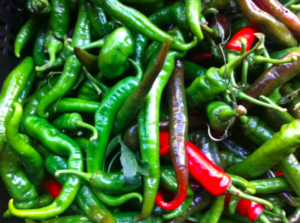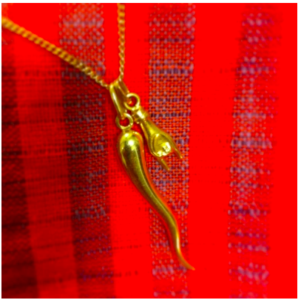 Chilis are a diverse fruit that bloom on the nightshade family of plants. Not only do chilis enhance the flavor of food, they also have a dual function of nurturing life by treating pain as well as halting humans in riot control. In this sense, chilis embody the the Daoist nature of the Yin Yang symbol where opposites are intrinsically connected.
Chilis are a diverse fruit that bloom on the nightshade family of plants. Not only do chilis enhance the flavor of food, they also have a dual function of nurturing life by treating pain as well as halting humans in riot control. In this sense, chilis embody the the Daoist nature of the Yin Yang symbol where opposites are intrinsically connected.
Chilis are also a natural and safe way to protect crops from vermin, dogs and even elephants by adding it to feed or lining the perimeter of fields with chilis. This diverse fruit boasts a variety of macabre names and grow in numerous grades of intensity and shades of greens to red. From topical salves for arthritis to euphoria inducing salsas to legendary 90’s rock band, chili peppers attract millions of people worldwide.

Chili peppers have been a part of the human diet in the Americas since at least 7500 BC. Some historians credit Chrisopher Colombus for “stumbling” upon peppers in the Caribbean and disseminating them throughout Europe and the East through trade routes. Others believe that the Spanish missionaries were drawn to the chilis widely used in Mexico and South Americans. Today chilies are at the core of many cuisines worldwide, namely Asian and South American cuisines.
The hottest portion of the chili pepper is the white membrane, or placenta, that surrounds the seeds. This protective sheath keeps mammals from destroying the seeds in the wild whilst they do not affect birds at all, which helps spread the seed. The placental portion contains capsaicin that has been identified as a compound that elevates the body temperature, produces sweating and increases heart rate. It is an irritant for mammals, including humans, and produces a sensation of burning in any tissue with which it comes into contact. Capsaicin in the eyes and nose produces extreme discomfort, which is what makes it effective for crowd control.
Chilis are so hot that they are graded on an international scale called the Scoville Scale. The Scoville number refers to how much dilution would be needed to render the heat imperceptible. Currently Wikipedia lists the world’s hottest chili peppers as:
Carolina Reaper: 2.2M SHU
Trinidad Moruga Scorpion: 2.0M SHU
Bhut Jolokia: 1.58M SHU
Trinidad Scorpion Butch: 1.463M SHU
Naga Viper: 1.4M SHU
Defense:
Many sources credit the Bhut Jolokia as the hottest pepper on earth. It is also known as the “Ghost Pepper” because presumably one “gives up the ghost” after consuming it.Just to put this into perspective, the Jalapeno measures 2,500 – 8,000 SHU.
In other words, the Jalapeno could be pulverized and used as baby food compared to the aforementioned chilis. These peppers listed above are pure gut wrenching, havoc-wreaking torture that create legends (or ER patients) at chili eating contests worldwide. Alternatively, these peppers are used as non-lethal weaponry such as the Bhut Jolokia grenades used by India’s Defense Ministry against protesters in Kashmir. Pepper spray is still widely accepted as a useful & powerful tool for self – defense.

Medicinal uses:
When capsaicin touches the skin it creates a numbing effect, which is why it is used in topical ointments, dermal patches and nasal spray to temporarily relieve pain. This can be used to treat arthritis, psoriasis, muscle strain and peripheral neuropathy. Internally capsaicin increases blood flow and promotes sweating.
In Traditional Chinese medicine chilies are considered Yang in nature because they are hot and stimulate heat within the body. Taken internally peppers are effective for the treatment of “exterior” conditions such as the common cold. Cayenne pepper has been traditionally used to create a sweat at the onset of a cold. An early sweat can help release the pathogen and prevent the cold from settling in.
Additionally, chilies and spicy food in general is considered tonifying for people who tend to be cold, sluggish, phlegmy…chilies eaten can stoke the digestive fire and increase metabolism.
Aesthetics:

The Calabrese region of Italy boasts the Calabrian pepper, affectionately dubbed the Devil’s Kiss, which has been appropriated into a pendant called a “cornicello”. Some people consider the “cornicello” to be a horn and others a calabrian pepper. Either way, the pepper is used a kind of talisman to ward off evil spirits.
This is one of my favorite Italian American symbols, as a kid growing up in the Bronx in the late 80’s Red peppers dangled from the rearview mirrors of cars…(mostly IROCs or cars of a similar nature). Of Italian American decent myself, I began donning a pepper in high school and have been wearing one on and off ever since. The pepper is a big part of my life both past and present.
To eat a great meal and sense both pleasure and pain in one dish is what some people (myself included) consider real gastronomic pleasure. When my mouth feels like it will ignite into flames…as my heart rate increases and I start sucking air through pursed lips and beads of sweat accumulate on my forehead, I think “aaah…I’m alive”. I can’t help but enjoy the little bit of torture, it’s that little bit of reality that sharpens my focus and helps me remain on my toes. Since adrenalin rich sports have taken a back burner in my life, habanero-rich meals help keep the day-to-day a little more dicey.
